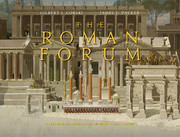Book contents
- Frontmatter
- Map
- Contents
- Preface
- Acknowledgments
- Part I. Architecture in the Roman Forum during the Empire: A Brief History
- Part II. The Monuments
- 3 The Temple of Antoninus and Faustina
- 4 The Temple of Caesar (Aedes divi Iuli)
- 5 The Basilica Æmilia
- 6 The Curia
- 7 The Arch of Septimius Severus
- 8 Minor Monuments
- 9 The Temple of Concord
- 10 The Temple of Vespasian
- 11 The Tabularium
- 12 The Portico of the Dei Consentes
- 13 The Temple of Saturn
- 14 The Basilica Julia
- 15 The Arch of Tiberius
- 16 The Schola Xanthi
- 17 The Diocletianic Honorary Columns
- 18 The Temple of Castor and Pollux
- 19 The Parthian Arch of Augustus (19 BCE)
- 20 The Temple of Vesta
- Part III. Conclusions
- Glossary
- Notes
- Bibliography
- Sources for Coin Images from the Internet and for Other Images
- Index
6 - The Curia
from Part II. - The Monuments
Published online by Cambridge University Press: 05 March 2015
- Frontmatter
- Map
- Contents
- Preface
- Acknowledgments
- Part I. Architecture in the Roman Forum during the Empire: A Brief History
- Part II. The Monuments
- 3 The Temple of Antoninus and Faustina
- 4 The Temple of Caesar (Aedes divi Iuli)
- 5 The Basilica Æmilia
- 6 The Curia
- 7 The Arch of Septimius Severus
- 8 Minor Monuments
- 9 The Temple of Concord
- 10 The Temple of Vespasian
- 11 The Tabularium
- 12 The Portico of the Dei Consentes
- 13 The Temple of Saturn
- 14 The Basilica Julia
- 15 The Arch of Tiberius
- 16 The Schola Xanthi
- 17 The Diocletianic Honorary Columns
- 18 The Temple of Castor and Pollux
- 19 The Parthian Arch of Augustus (19 BCE)
- 20 The Temple of Vesta
- Part III. Conclusions
- Glossary
- Notes
- Bibliography
- Sources for Coin Images from the Internet and for Other Images
- Index
Summary
The Curia Hostilia
According to Livy, Romulus (771–717 BCE), Rome’s legendary founder, established the Senate, originally a royal advisory council of a hundred men, the heads of the noble clans (patres) whose descendants became Rome’s aristocracy (the patricians). Where the Senate held its sessions in the early decades of its existence is unknown. Eventually, using war booty from the conquest of the neighboring Latin town of Alba Longa, King Tullius Hostilus (672–641) brought the Alban aristocrats to Rome and, for his newly enlarged Senate, built a “meeting house,” a Curia (Fig. 1.1), on the northwest side of the Forum just north of and adjacent to the voting area (the Comitium) for Rome’s earliest popular assembly, the comitia curiata. Like the surviving building, this Curia, “which,” says Livy, “continued to be called the Curia Hostilia as late as the time of our own fathers,” was a rectangular structure with a wooden roof that was formally considered a temple. Oriented to the cardinal points, its south entrance opened directly into the Comitium, an area enclosed by rows of seats that served as the Curia’s steps. Major historical paintings decorated the interior. The one installed in 363 by M. Valerius Messala commemorated his Sicilian victory over King Hiero of Syracuse and the Carthaginians during the First Punic War.
- Type
- Chapter
- Information
- The Roman ForumA Reconstruction and Architectural Guide, pp. 116 - 132Publisher: Cambridge University PressPrint publication year: 2015



